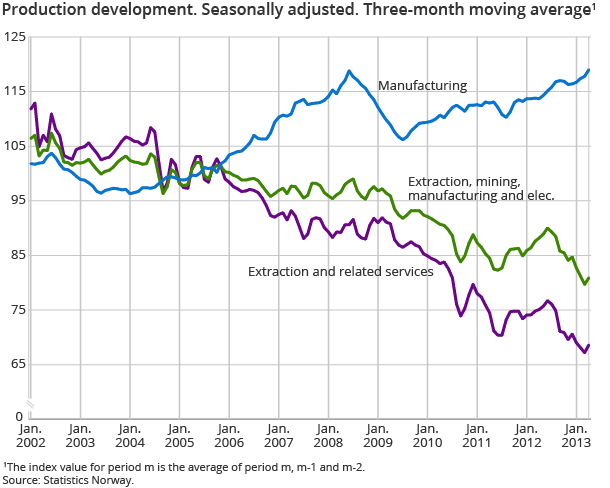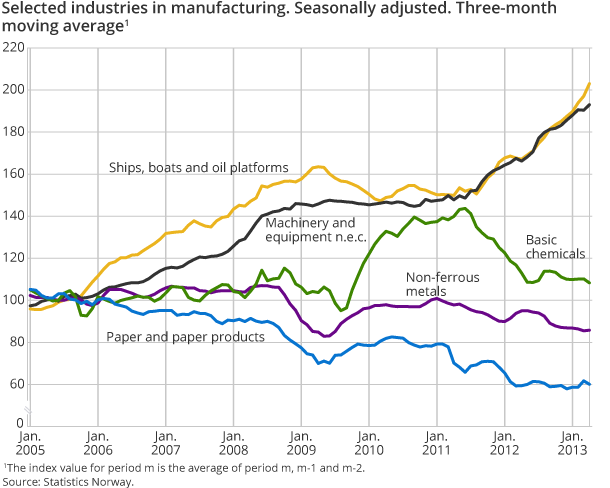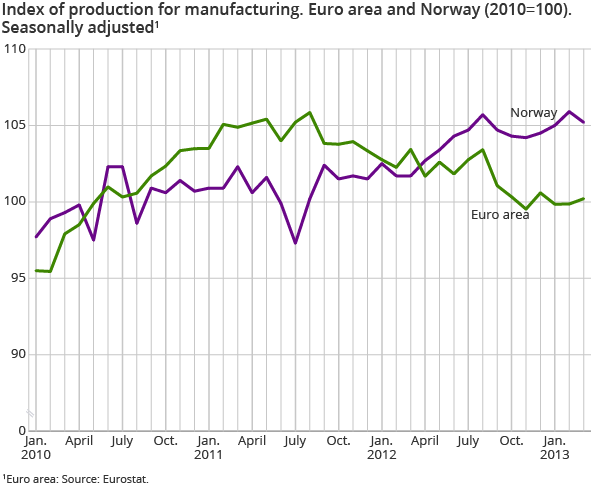Content
Published:
This is an archived release.
Strong oil-driven growth in manufacturing
Production in Norwegian manufacturing went up by 2.0 per cent from February to April 2013 compared with the previous three-month period, according to seasonally-adjusted figures. The (overall) index of industrial production (PII), however, decreased due to a fall in extraction of natural gas in this period.
| Seasonally adjusted | Calender adjusted1 | Weights2 | ||
|---|---|---|---|---|
| Monthly change | Three-month change | Twelve-month change | ||
| April 2013 / March 2013 | February 2013 - April 2013 / November 2012 - January 2013 | April 2013 / April 2012 | ||
| 1Adjusted for working-days and for public holidays in Norway. | ||||
| 2The weights are updated annually, and are valid for the entire year. | ||||
| Extraction, mining, manufacturing and elec | 5.4 | -2.2 | -5.3 | 100.0 |
| Extraction and related services | 8.4 | -0.6 | -4.2 | 73.5 |
| Mining and quarrying | 2.3 | -2.1 | -4.5 | 0.6 |
| Manufacturing | 2.6 | 2.0 | 6.1 | 20.1 |
| Food, beverage and tobacco | -1.1 | -2.7 | -3.4 | 3.8 |
| Refined petro., chemicals, pharmac. | 3.2 | 0.9 | 4.2 | 2.0 |
| Basic metals | -2.2 | -1.9 | -9.9 | 1.1 |
| Machinery and equipment | 5.2 | 2.7 | 21.8 | 2.8 |
| Ships, boats and oil plattforms | 1.6 | 7.0 | 23.9 | 2.1 |
| Electricity, gas and steam | -7.3 | 0.7 | -21.0 | 5.9 |
Extraction of natural gas went down by 3.6 per cent, while extraction of crude oil increased by 1.4 per cent from February to April 2013 compared with the previous three-month period. The downturn in extraction of natural gas is related to technical difficulties in several fields on the Norwegian continental shelf. For further details, refer to the press release from The Norwegian Petroleum Directorate.
Seasonally-adjusted figures from February to April 2013 show a further increase in output for industries such as machinery and equipment, ships, boats and oil platforms and repair and installation of machinery. A continued high workload has resulted in record-high output levels in machinery and equipment and ships, boats and oil platforms. Since 2005, industries like machinery and equipment and ships, boats and oil platforms have experienced a production growth of 93 and 103 per cent respectively. Repair and installation of machinery has also seen a significant growth in the last three-month period and the output has increased by over 90 per cent since 2005. According to seasonally-adjusted figures from February to April 2013, the overall output in Norwegian manufacturing is now equivalent to the record levels seen before the financial crisis (June 2008).
Increasing differences within Norwegian manufacturing
On the other hand, industries like basic chemicals and non-ferrous metals experienced a continued downturn in production from February to April 2013. Compared with figures from 2005, basic metals have had a production drop equivalent to over 22 per cent. The differences between industries linked to the Norwegian oil and gas industries and more traditional Norwegian export industries have thereby continued to increase so far in 2013. In addition, there has also been a decrease in production of food and food products from February to April 2013. This can be related to lower production of fish and fish products, and low production of feed, compared with previous periods.
Solid increase in manufacturing from April 2012 to April 2013
The output in manufacturing saw a growth of 6.1 per cent from April 2012 to April 2013, according to calendar-adjusted figures. Since April 2012, industries like machinery and equipment and ships, boats and oil platforms have had a significant production growth equivalent to over 20 per cent. Meanwhile, food and food products, basic chemicals and basic metals experienced a decline in production in the same period.
Growth in manufacturing from March to April 2013
The production in Norwegian manufacturing went up by 2.6 per cent from March to April 2013, according to seasonally-adjusted figures. There has been a solid production growth in industries such as fabricated metal products, machinery and equipment, as well as for ships, boats and oil platforms. In addition, production of basic metals also went up in April 2013, after a large production drop in the previous month. For food and food products and basic metals, the output went down from March to April 2013.
Norway and the euro area
There was a 3.5 per cent increase in Norwegian manufacturing output from March 2012 to March 2013, according to calendar-adjusted figures. Industrial production in the euro area decreased by 3.3 per cent in the same period, according to figures published by Eurostat.
Decrease in production within electricity supply from April 2012 to April 2013
The production within Norwegian electricity supply decreased by 21.0 per cent from April 2012 to April 2013, according to unadjusted figures.
Interpretation of seasonally-adjusted figuresOpen and readClose
In order to facilitate the interpretation of the short-term development, the index of production publishes three-month moving averages of the seasonally-adjusted figures. We normally compare the latest non-overlapping three-month periods, for instance February to April 2013 compared with November 2012 to January 2013. Seasonally-adjusted monthly changes must be interpreted with caution.
On the effect of EasterOpen and readClose
It is important to be aware that the uncertainty for the calendar-adjusted and seasonally-adjusted indices for March and April is greater than normal due to the changed placing of Easter. This effect will also affect the seasonally-adjusted figures for the 1st and 2nd quarters. This is accounted for when adjusting for seasonal variations. However, it can still be difficult to adjust for all impacts.
Contact
-
Production and turnover
E-mail: prodoms@ssb.no



